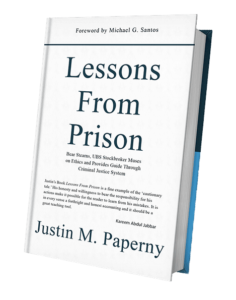Goals of A Sentencing Narrative
Yesterday, I received a call from Bob, a 24 year old salesman from Newport Beach, CA. Bob called me after watching a video I filmed, Tips From A Federal Judge On How To Get A Shorter Federal Prison Term. From the moment we began talking, I could hear Bob was anxious to express to his Judge the remorse he feels and his plans moving forward–two concepts we teach in our sentencing course.
“Can you tell me more about these stakeholders you reference in your blogs and videos? Do you mean the Judge? I want to work on a sentencing narrative that will help me influence all of these stakeholders,” he told me.
I love that Bob watched the video, then took action. It may sound off putting, but our work is not for defendants who only watch our videos or read our blogs. Our work is for those who take action and learn to ask tough questions. If a white collar defendant or any defendant for that matter only watches or reads, but takes no action, I cannot help. It is that simple. By definition action means, “the fact or process of doing something.” In our case, “DOING” as it relates to a sentencing narrative, means learning about the stakeholders, then investing the time to create a compelling first person narrative. Bob was ready…
When we write a sentencing narrative, we write to influence stakeholders of the system. Who are these stakeholders?
Prosecutors: Prosecutors score victories with convictions and long sentences. They highlight criminal charges and negative characteristics to build a persuasive case for a conviction and severe sanction.
Probation Officer: A Probation Officer will craft a presentence investigation report (PSR) that support the prosecutor’s version of events. Defendants sow seeds for a better outcome if they’re successful at influencing the outcome of the PSR.
Federal Judge: In most instances, federal judges have experience as former prosecutors. Consider how those experiences may bias a judge’s opinion of the defendant.
Defense Attorney: To argue for the lowest sentence, a defense attorney will rely upon the law and previously decided cases. Defendants can help their attorneys make a stronger case for mercy when they present compelling personal life stories.
Bureau of Prisons:Staff members in the Bureau of Prisons that may or may not meet the defendant will rely upon the PSR and government’s version of events to make decisions that have an enormous influence on the defendant’s life. An effective personal narrative will influence the defendant’s journey long after the judge imposes sentence.

Goals of A Sentencing Narrative
Now that we understand the stakeholders, let’s identify the goal of a sentencing narrative.
As you can see, our audience includes people (stakeholders) that have enormous discretion and influence over the lives of our clients. We want the probation officer, prosecutor, and judge to see and appreciate the defendant as an individual who gets the seriousness of the moment. That means an effective sentencing narrative will accomplish the following tasks:
1. Identify with the victim’s loss and suffering.
2. Express influences that led to the acts in question.
3. Articulate true remorse.

Goals of A Sentencing Narrative
4. Show what the defendant learned from this experience.
5. Define what steps the defendant is taking to reconcile and make things right.
6: Persuade the judge that defendant will never break law again.
7. Prove that the defendant is worthy of mercy.

Goals of A Sentencing Narrative
Ideally, we want all stakeholders to see the individual as a person, balancing the negative characteristics that the government will highlight. We accomplish this task by writing an individual’s life story in a first-person sentencing narrative. Some clients, like Bob, invest in our sentencing narrative course, then write the narrative on their own. After our client drafts the sentencing narrative, we review and edit it.
Writing an effective sentencing narrative requires a considerable amount of time, thought and ACTION! I highly admire Bob because he choose to not just think about the right thing to do–he did it. And not only did he do it, we knocked out a wonderful sentencing narrative in less than 24 hours.
Justin Paperny




